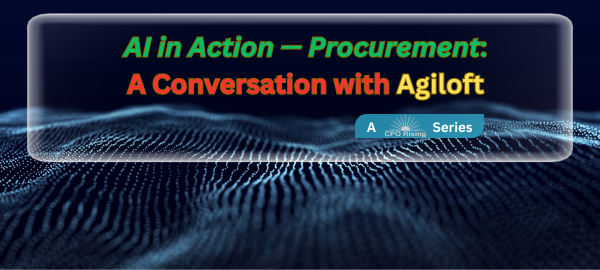A New AI Series on CPO Rising
The power of artificial intelligence (AI) is undeniable. Its impact and influence are revolutionizing the Procurement automation market. According to research from Ardent Partners, AI will soon be ubiquitous in this sector, offering unparalleled efficiencies and capabilities. The transformative possibilities of AI will drive innovations in source to pay, eSourcing, risk management, and overall supply chain management, streamlining enterprise operations and improving business decision-making.
In view of these advancements, Ardent Partners is excited to announce a special “AI in Action” interview series. We invite your company to participate in this series and contribute to the thought leadership around AI by having a product or strategy executive respond to high-level questions from Andrew Bartolini, our Founder and Chief Research Officer for Ardent Partners.
Today’s AI in Action profile features a conversation with Agiloft’s Simon Jones, Director of Product Marketing.
AB: Good day Simon, tell our readers a little bit about yourself.
SJ: My name is Simon Jones and I’m the director of product marketing for Agiloft.
AB: Thank you. I think I know your answer but let me ask anyway … what are the biggest opportunities for AI to improve procurement efficiencies and productivity?
SJ: Procurement teams are vital to every organization, managing the sourcing, negotiation, and finalization of contracts with suppliers as well as ensuring that both parties are aligned on terms and conditions. But let’s face it, procurement has always been a bit of a paperwork jungle, where efficiency is often as elusive as the mythical creature known as “the perfect vendor.” Manually managing all these contracts is a time-consuming and daunting task with nearly half of organizations saying that their procurement and supplier contract activities are at least 75% manual.

But the good news is that AI is here to free you from the slog of paperwork. One of the biggest opportunities for AI in the procurement world is automation — more specifically, automating tasks that eat up a ton of time and don’t require much brainpower. Think: generating purchase orders, assessing supplier risks, invoice matching, and contract analysis. These are all areas ripe for the picking. Tools like contract lifecycle management (CLM) platforms enable AI to process hundreds of documents in seconds, identifying invisible trends, and even flagging potential problems before they become big headaches — eliminating the need for tedious manual tasks.
Another major opportunity for AI lies in efficiency. You can’t buy what you don’t know you’ll need, but by analyzing historical data and market trends, AI can forecast demand with an impressive degree of accuracy, helping procurement teams make better decisions, especially when it comes to overseeing agreements between businesses and suppliers, which can be complex and time-consuming. AI-powered CLM platforms can also help optimize supplier selection and negotiation strategies by summarizing contracts, automating tasks, and ensuring compliance.
Automating the procurement contract process facilitates smoother collaboration between procurement and contracting teams. With AI-based solutions, teams can seamlessly exchange information, review contracts together, and address any potential legal concerns or risks. Automation streamlines communication channels, allowing every department to work in sync, ensuring that contracts are compliant, accurate, and aligned with organizational objectives. In short, AI can do boring, repetitive stuff and leave engaging, strategic work for procurement teams.
AB: How are you ensuring the accuracy and reliability of customers’ AI models (AI data output)?
SJ: If you’re anything like me, you’ve been burned by “trust me, it’s accurate” promises more times than you’d like to admit. The truth is, ensuring the accuracy and reliability of AI models isn’t just about throwing some data into a fancy algorithm and hoping for the best. It’s about data quality, maintenance, oversight, training, constant iteration, and more training.
One way to ensure accuracy is through quality data. AI is only as good as the data it’s trained on, and bad data equals bad output. So, we focus on cleaning and validating data before it even gets near an AI model. The better the quality of the input data, the more reliable the output will be. It’s important to ensure continuous monitoring of AI models during and after deployment. AI isn’t static — it learns, adapts, and improves over time, so keeping a close eye on performance ensures it’s not drifting into “oops, that wasn’t what we meant” territory. If AI makes a mistake, it needs to learn from it. By incorporating human feedback into the system, we can ensure that the AI models are constantly improving. This way, we’re making the AI smarter, but also more reliable, over time. If your AI doesn’t improve with time, you’re basically stuck with a very expensive version of a magic eight-ball. And nobody wants that.
For example, Agiloft’s GenAI Prompt Lab is the only solution that invites customers to bring their own Large Language Models (LLMs), connect with contracts, and achieve goals faster by sharing prompt templates organization-wide. This means that customers can use their own LLMs with Agiloft’s AI to enable smart actions to their contracting workflows that are 100% tuned to their organizational idiosyncrasies. Finally, they can throw off the yoke of vendor-mandated models, and ensure the accuracy, relevance, and quality of their own data while still being able to utilize custom prompts, such as assessing red flags or anonymizing clauses, for their contracting needs.
AB: What are the leading AI subsets (e.g., machine learning, natural language processing, deep learning, etc.) with the biggest impact on procurement solutions? And why?
SJ: There are a ton of AI subsets, but if we’re talking about the ones really driving the evolution in procurement, it’s hard to ignore a few key players: machine learning (ML) and natural language processing (NLP). Working with AI, ML, and NLP, procurement solutions can help teams cut down on time-consuming tasks, increase efficiency, and streamline processes to accelerate their business.
Machine learning is like the Swiss Army knife of AI and it’s everywhere in procurement. From demand forecasting to supplier risk analysis, machine learning models can analyze historical data and trends to predict future outcomes. But the real magic happens when ML is used for optimization. Machine learning can process vast amounts of data to identify patterns that would take a human forever to notice. It’s the behind-the-scenes engine of procurement’s “smart” decisions and helps evolve analytical insights from “things we could do” to “things we should do.”
If you’ve ever tried to sort through hundreds of pages of contracts or supplier agreements, you’ll understand the true power of NLP. With natural language processing — the ability for machines to understand, interpret, and generate human language — suddenly you can make those documents intelligible to people with not an ounce of legal training, and empower them to execute things like automated contract analysis, drafting clauses, and even using chatbots to answer questions within a contract in real time. When you pair NLP with machine learning, the result is a system that can read, comprehend, and learn from documents, turning mountains of text into actionable insights.
AB: How can you support procurement clients when an AI skills gap deficiency exists?
SJ: At Agiloft, we provide thorough customer onboarding, with detailed documentation, training, and support to ensure smooth adoption of our platform. But let’s be honest — AI isn’t something everyone just gets right out of the gate. To support those who don’t have a strong AI background, it’s about more than just handing them an AI tool and saying, “good luck!” The real key is education. It’s important to walk procurement clients through the AI process and focus on real-world applications, not just theory. We show them how AI can solve specific pain points in their day-to-day operations.
AB: How do you view your customers’ (and prospective customers’) AI attitudes?
SJ: It varies — some are all in, while others are still trying to figure out whether AI is the Next Big Thing. But if there’s one thing you can’t miss, it’s that fear and skepticism are still major hurdles. The idea that AI will replace humans is a common concern, which is understandable, given all the media hype. But AI is more about augmentation than replacement: it’s a tool that can take over repetitive tasks, freeing up your team to focus on higher-value work. It’s about working smarter, not harder.
On the flip side, I see a lot of excitement about AI’s potential to streamline processes, reduce costs, and drive innovation. The early adopters are often the ones who’ve seen firsthand how AI can save time and boost efficiency and productivity. While they see AI as a must-have, the reality is that most customers are cautiously optimistic. They want to see ROI but they’re also wary of investing in something that might not live up to the hype. There’s also the concern of inaccuracy and data privacy when it comes to AI. It’s our job to show them the tangible benefits and help them understand that AI isn’t a gamble — it’s an evolution. As AI becomes more mainstream, I expect customers’ attitudes to shift more toward enthusiastic acceptance, especially once they recognize that it is a tool, rather than a freestanding solution, and can see how it tangibly improves their business.
AB: Where do you see AI solution offerings within procurement in five years?
SJ: AI will likely transform from a set of niche tools into a ubiquitous, behind-the-scenes partner across industries. We’ll see a shift from AI being a specialized solution to becoming a part of everyday workflows across industries like healthcare, finance, and retail. The future of AI will need to balance innovation and responsibility. As more research is being done on AI, it’s important to ensure that its nope capabilities are harnessed in ways that are beneficial to society, not just businesses.
AB: I appreciate your time today!
SJ: Thank you.

